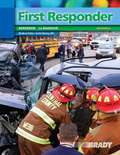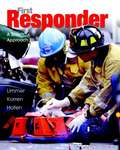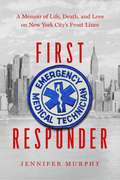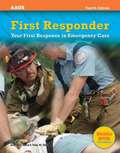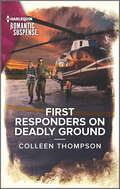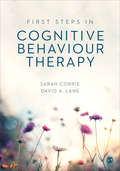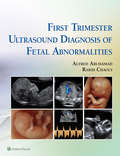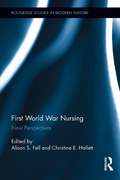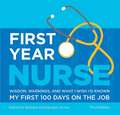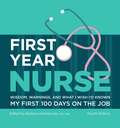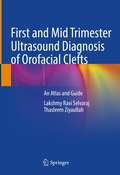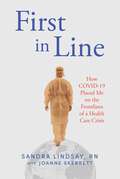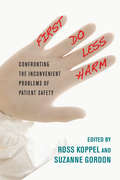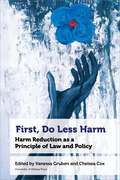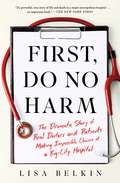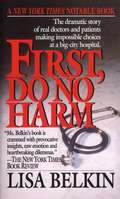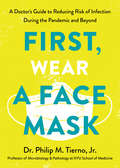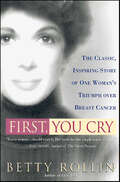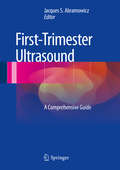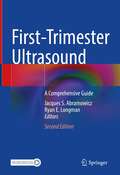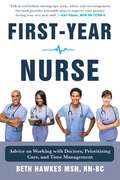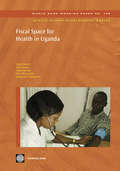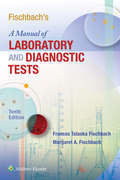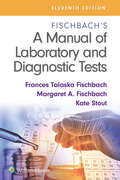- Table View
- List View
First Responder (8th edition)
by J. David Bergeron Gloria Bizjak Chris Le Baudour Keith WesleyThe leader in the field, this easy-to-understand text provides clear First Responder-level training for fire service, emergency, law enforcement, military, civil, and industrial personnel.
First Responder: A Skills Approach
by Daniel Limmer Keith J. Karren Brent Q. HafenThe 7th edition of this popular First Responder title, takes students beyond national standards while retaining the easy-to-read, step-by-step format that has made it a favorite for over a decade. Comprehensive coverage includes a variety of topics, including material that goes beyond the DOT curriculum and airway and circulation chapters that fully comply with the newly revised AHA Guidelines. New features, enrichment materials will enhance the clear and in-depth coverage that has been this titles trademark. New material has been added on terrorism, industrial emergencies, and special patients, as well as a new chapter on Geriatric Emergencies. A new special feature First Responder Flash highlights key information. First Responder students and professionals.
First Responder: Life, Death, and Love on New York City's Frontlines: A Memoir
by Jennifer MurphyOne woman's incredible story of life on the front lines as an emergency medical worker in New York City.On the streets of New York City, EMTs and paramedics do more than respond to emergencies; they eat and drink together, look out for each other&’s safety, mercilessly make fun of one another, date one other, and, most crucially, share terrifying experiences and grave injustices suffered under the city&’s long-broken EMS system. Their loyalty to one another is fierce and absolute. As Jennifer Murphy shows in the gripping and moving First Responder, they are a family. A dysfunctional family, perhaps, but what family isn't? Many in the field of pre-hospital emergency care have endured medical trauma and familial hardship themselves. Some are looking to give back. Some are desperate for family. Some were inspired by 9/11. Still others want to become doctors, nurses, firefighters, cops, and want to cut their teeth on the streets. As rescuers, they never want people to die or get hurt. But if they are going to die or get hurt, first responders want to be there. Despite the vital role they play New York City, EMTs are paid less than trash collectors, and far less than any other first responder makes, even though the burden of medical emergencies fall on the backs of EMTs and medics. Yet for Jennifer and her brothers and sisters, it's a calling more than a job. First responders are constantly exposed to infectious diseases, violence, and death. The coronavirus pandemic did not change that math; the public is just more aware of it. After 9/11, EMT training schools experienced a surge in applications from civilians wanting to become first responders, inspired by rescuers who responded to the terrorist attacks and rushed into the burning towers when everyone else ran out. The same will almost certainly be true post-coronavirus as people are moved by a desire to help in times of crisis in a more direct way. Funny and heartwarming, inspiring and poignant, First Responder follows Jennifer's journey to becoming an EMT and working during and beyond the Covid-19 pandemic. She will bring readers inside an intense world filled with crisis, rescue, grief, uncertainty, and dark humor. First Responder will move readers to a greater understanding and appreciation of those fighting for them—wherever they live—in a world they hardly know or could imagine.
First Responder: Your First Response in Emergency Care (4th Edition)
by David SchottkeThe only First Responder training program endorsed by a national organization, First Responder, Fourth Edition continues with an assessment-based approach to First Responder training. The Fourth Edition fully integrates the 2005 CPR and ECC guidelines and includes new chapters on: communications and documentation; geriatric emergencies; and terrorism awareness. Designed to meet the needs of law enforcement personnel, fire fighters, rescue squad personnel, athletic trainers, college students, and laypersons, the new features found in the Fourth Edition will help students take the next step toward becoming outstanding First Responders. These features include: endorsement by the American Academy of Orthopaedic Surgeons; You are the Provider, attention-grabbing case studies found in every chapter; Special Population Tips, disucssing the specific needs and emergency care of special populations, including pediatric, geriatric, and special needs patients; Enhanced skill drills; and First Responder Practical Skills Review DVD, packaged free with the Fourth Edition. The Fourth Edition fully integrates the 2005 CPR and ECC guidelines and includes new chapters on:++ Communications and Documentation++ Geriatric Emergencies++ Terrorism AwarenessDesigned to meet the needs of law enforcement personnel, fire fighters, rescue squad personnel, athletic trainers, college students, and laypersons, the new features found in the Fourth Edition will help students take the next step toward becoming outstanding First Responders. These features include:++ Endorsement by the American Academy of Orthopaedic Surgeons++ You are the Provider, attention-grabbing case studies found in every chapter ++ Special Population Tips, discussing the specific needs and emergency care of special populations, including pediatric, geriatric, and special needs patients++ Enhanced skill drills++ First Responder Practical Skills Review DVD, packaged free with the Fourth Edition
First Responders on Deadly Ground
by Colleen ThompsonA disaster drew them close…and now they're in inescapable danger. Ever since a powerful family destroyed his mother's life, helicopter paramedic Jude Castleman has burned for justice. Only now, working with widowed flight nurse Callie Fielding, does it seem possible. Discovering they are both linked to the same fatal chopper crash, the grief-stricken pair embark on a high-risk plan of revenge and closure…as they try to resist their even riskier attraction. From Harlequin Romantic Suspense: Danger. Passion. Drama.
First Steps in Cognitive Behaviour Therapy
by Sarah Corrie David A. LaneThis book is a first steps introduction to cognitive behaviour therapy that will appeal to the interested reader and professionals wanting to learn about the approach. It introduces you to the history of the approach, describes its behavioural and cognitive principles, and examines key techniques and methods within the context of contemporary practice. Further chapters on Formulation, Working with Imagery, and Future Directions in CBT help you to extend your learning, while reflective activities and case studies throughout the book support you to apply principles and perspectives to practice.
First Steps in Cognitive Behaviour Therapy
by Sarah Corrie David A. LaneThis book is a first steps introduction to cognitive behaviour therapy that will appeal to the interested reader and professionals wanting to learn about the approach. It introduces you to the history of the approach, describes its behavioural and cognitive principles, and examines key techniques and methods within the context of contemporary practice. Further chapters on Formulation, Working with Imagery, and Future Directions in CBT help you to extend your learning, while reflective activities and case studies throughout the book support you to apply principles and perspectives to practice.
First Trimester Ultrasound Diagnosis of Fetal Abnormalities
by Alfred Z. Abuhamad Rabih ChaouiStay up to date with recent advances in the use of ultrasound in early gestation with this comprehensive, full-color reference. First Trimester Ultrasound Diagnosis of Fetal Abnormalities is an authoritative, systematic guide to the role of first trimester ultrasound in pregnancy risk assessment and the early detection of fetal malformations. High-quality illustrations and numerous tables throughout enhance readability, making this text an excellent daily resource in clinical practice.
First World War Nursing: New Perspectives (Routledge Studies in Modern History #11)
by Christine E. Hallett Alison S. FellThis book brings together a collection of works by scholars who have produced some of the most innovative and influential work on the topic of First World War nursing in the last ten years. The contributors employ an interdisciplinary collaborative approach that takes into account multiple facets of Allied wartime nursing: historical contexts (history of the profession, recruitment, teaching, different national socio-political contexts), popular cultural stereotypes (in propaganda, popular culture) and longstanding gender norms (woman-as-nurturer). They draw on a wide range of hitherto neglected historical sources, including diaries, novels, letters and material culture. The result is a fully-rounded new study of nurses’ unique and compelling perspectives on the unprecedented experiences of the First World War.
First Year Nurse
by Barbara ArnoldussenYour first 100 days at a new job could be daunting---unless you go in prepared. First Year Nurse places the wisdom and warnings of hundreds of experienced nurses right at your fingertips. You'll learn all about how to start off on the right foot; plan and prioritize; communicate with your colleagues; cope with challenging patients; keep your energy up (and stress down); and set a course for professional growth.Best of all, you'll be inspired by the compassion, insight, and enthusiasm you'll find on every page of this charming, helpful book.Features:Valuable advice and personal accounts from experienced nurses;Tips on subjects from time management to avoiding burnout.
First Year Nurse: Wisdom, Warnings, and What I Wish I'd Known My First 100 Days on the Job
by Barbara ArnoldussenYour first 100 days at a new job could be daunting--unless you go in prepared. First Year Nurse places the wisdom and warnings of hundreds of experienced nurses right at your fingertips. You'll learn all about how to start off on the right foot, plan and prioritize, communicate with your colleagues, cope with challenging patients, keep your energy up (and stress down), and set a course for professional growth. Best of all, you'll be inspired by the compassion, insight, and enthusiasm you'll find on every page of this charming, helpful book.First Year Nurse features:* Valuable advice and personal accounts from experienced nurses* Tips on subjects from time management to avoiding burnout
First and Mid Trimester Ultrasound Diagnosis of Orofacial Clefts: An Atlas and Guide
by Lakshmy Ravi Selvaraj Thasleem ZiyaullahThis book aims to highlight all the existing information available on first and mid-trimester imaging of palate in prenatal ultrasound and to develop a methodical approach in imaging the palate. As formation of the palate is completed by 11 weeks of gestation and as there are no evolving changes in palatine anatomy at the mid-trimester, diagnosis of palatine clefts can now completely be shifted to late first-trimester. First-trimester evaluation of palate is now gaining importance and a number of techniques have currently been proposed by different authors.This book covers the existing literature and recent 2D and 3D techniques in evaluating palate and helps in the early detection of palatine clefts in the first trimester. Orofacial clefting is one of the most common birth defects and the burden of it in developing countries is substantial. This book helps in improving the counseling options for the obstetrician and the couple early in gestation. It includes 2D and 3D images of various types of palatine clefts and the nuances in imaging the secondary palate extensively. 3D images of the palate also help the multi-disciplinary team especially the maxillofacial surgeons involved in managing orofacial clefts. It also includes videos for easy understanding.This book is a ready reckoner for the imaging specialists and students /trainees involved in prenatal diagnosis. It provides essential information in diagnosing orofacial cleft both to the novice and to the skilled professionals involved in the field of diagnostic fetal ultrasound.
First in Line: How COVID-19 Placed Me on the Frontlines of a Health Care Crisis
by Sandra LindsaySandra Lindsay, the first person to receive the COVID-19 vaccine, takes the reader on her journey from humble immigrant beginnings in 1980s Bronx to national health equity advocate and winner of the Presidential Medal of Freedom.Sandra Lindsay immigrated to the United States from Jamaica in 1986 with ambitions of becoming a nurse and living the American Dream. In December 2020, she became the first person to receive the COVID-19 vaccine and was subsequently honored with the Presidential Medal of Freedom. Lindsay tells her inspiring story, from leaving a stable home in Jamaica only to experience years of struggle in the Bronx, NY, as a single mother and struggling student. Her tenacity led to a successful thirty-year nursing career, including her leadership as the director of critical care at Northwell&’s Long Island Jewish Medical Center during the country&’s worst health crisis in 2020. In First in Line Lindsay lays out her triumphs and setbacks as a single mother and working student who overcomes barriers with the love of her family and the support of mentors and leaders. Her beginnings as a four-dollar-an-hour grocery store fortified her with the resilience to persevere over decades to become an executive at a globally recognized nationally known healthcare system. Lindsay recounts working through the darkest months of the COVID-19 crisis in 2020 and leading the critical care units at Long Island Jewish Medical Center. The suffering and losses she witnessed ignited Lindsay&’s passion for seeing an end to inequities in healthcare. First in Line tackles a variety of issues: bias and inequity in healthcare; chronic disease in marginalized communities; maternal, infant, and Black and Brown women&’s health; and mental health. While Lindsay continues to beat the drum for vaccination as COVID-19 continues to impact our lives, she advocates for a holistic approach for improved, equitable healthcare for all people who live on the margins.
First, Do Less Harm: Confronting the Inconvenient Problems of Patient Safety (The Culture and Politics of Health Care Work)
by Ross Koppel Suzanne GordonEach year, hospital-acquired infections, prescribing and treatment errors, lost documents and test reports, communication failures, and other problems have caused thousands of deaths in the United States, added millions of days to patients' hospital stays, and cost Americans tens of billions of dollars. Despite (and sometimes because of) new medical information technology and numerous well-intentioned initiatives to address these problems, threats to patient safety remain, and in some areas are on the rise. In First, Do Less Harm, twelve health care professionals and researchers plus two former patients look at patient safety from a variety of perspectives, finding many of the proposed solutions to be inadequate or impractical. Several contributors to this book attribute the failure to confront patient safety concerns to the influence of the "market model" on medicine and emphasize the need for hospital-wide teamwork and greater involvement from frontline workers (from janitors and aides to nurses and physicians) in planning, implementing, and evaluating effective safety initiatives. Several chapters in First, Do Less Harm focus on the critical role of interprofessional and occupational practice in patient safety. Rather than focusing on the usual suspects-physicians, safety champions, or high level management-these chapters expand the list of "stakeholders" and patient safety advocates to include nurses, patient care assistants, and other staff, as well as the health care unions that may represent them. First, Do Less Harm also highlights workplace issues that negatively affect safety: including sleeplessness, excessive workloads, outsourcing of hospital cleaning, and lack of teamwork between physicians and other health care staff. In two chapters, experts explain why the promise of health care information technology to fix safety problems remains unrealized, with examples that are at once humorous and frightening. A book that will be required reading for physicians, nurses, hospital administrators, public health officers, quality and risk managers, healthcare educators, economists, and policymakers, First, Do Less Harm concludes with a list of twenty-seven paradoxes and challenges facing everyone interested in making care safe for both patients and those who care for them.
First, Do Less Harm: Harm Reduction as a Principle of Law and Policy (Health and Society)
by Vanessa Gruben Chelsea CoxReaders will be able to gain a deeper understanding of how different approaches to harm reduction can create a stronger foundation for more effective policies and legislation. Scholars from law and social sciences collaborate with frontline organizations as well as with individuals with lived experience to reflect diverse perspectives, and transform how society addresses substance-related challenges.Each chapter provides unique findings, drawing from examples of harm reduction strategies implemented for opioids, cannabis, and tobacco in Canada and beyond. While harm reduction has been a central aspect of the legal and policy responses to all three substances, its application has varied significantly. First, Do Less Harm explores how the ongoing opioid crisis emphasizes the pressing need for safe consumption sites and life-saving tools like naloxone. Case studies on Canada’s legalization of cannabis highlight both the benefits and challenges of providing legal and regulated access to a drug. The volume further examines the evolving landscape of tobacco regulations where recent innovations such as vaping offer less harmful alternatives, yet raise significant concerns about youth uptake and public health. Designed for policymakers, health professionals, academics, and anyone interested in creating safer communities, this collection not only presents thought-provoking ideas but also provides inspiration to take action.
First, Do No Harm: The Dramatic Story of Real Doctors and Patients Making Impossible Choices at a Big-City Hospital
by Lisa Belkin&“Crammed with provocative insights, raw emotion, and heartbreaking dilemmas,&” (The New York Times) First, Do No Harm is a powerful examination of how life and death decisions are made at a major metropolitan hospital in Houston, as told through the stories of doctors, patients, families, and hospital administrators facing unthinkable choices.What is life worth? And when is a life worth living? Journalist Lisa Belkin examines how these questions are asked and answered over one dramatic summer at Hermann Hospital in Houston, Texas. In an account that is fascinating, revealing, and almost novelistic in its immediacy, Belkin takes us inside a major hospital and introduces us to the people who must make life and death decisions every day. As we walk through the hallways of the hospital we meet a young pediatrician who must decide whether to perform a risky last-ditch surgery on a teenager who has spent most of his fifteen years in a hospital; we watch as new parents battle with doctors over whether to disconnect their fragile, premature twins from the machine that keeps them breathing; we are in the operating room as a poor immigrant, paralyzed from a gunshot in the neck, is asked by doctors whether or not he wishes to stay alive; we witness the worry of a kidney specialist as he decides whether or not to transfer an uninsured baby to the county hospital down the road. We experience critical moments in the lives of these real people as Belkin explores challenging issues and questions involving medical ethics, human suffering, modern technology, legal liability, and financial reality. As medical technology advances, the choices grow more complicated. How far should we go to save a life? Who decides? And who pays?
First, Do No Harm: The Dramatic Story of Real Doctors and Patients Making Impossible Choices at a Big-City Hosptial
by Lisa BelkinWhat is life worth? And what is a life worth living? <P> At a time when America faces vital choices about the future of its health care, former NEW YORK TIMES correspondent Lisa Belkin takes a powerful and poignant look at the inner workings of Hermann Hospital in Houston, Texas, telling the remarkable, real-life stories of the doctors, patients, families, and hospital administrators who must ask--and ultimately answer--the most profound and heartrendng questions about life and death.
First, Wear a Face Mask: A Doctor's Guide to Reducing Risk of Infection During the Pandemic and Beyond
by Dr. Philip M. TiernoStay safe and stay calm. A New York University microbiologist gives you the knowledge you need to protect yourself from COVID-19 and other common infectious diseases.With the spread of COVID-19, the world has never felt less safe. And with so much advice out there, it's hard to know whether you're taking the right precautions to stay safe. Don't panic: there are simple steps you can take to best protect yourself from infection.Professor of microbiology and pathology at NYU School of Medicine Dr. Philip M. Tierno Jr. cuts through the noise with to-the-point explanations, checklists, and best practices in this brief yet authoritative guide to protecting yourself from infectious diseases. First walking you through what germs are and how every infection happens, First, Wear a Face Mask offers calming, straightforward advice to address the ongoing spread of COVID-19 as well as the germs that imperil us every year. This practical approach will give you peace of mind as it helps you learn how to protect yourself in a variety of scenarios, from cooking at home to eating out, from your everyday commute to air travel. With tips and tidbits of history, he guides you through taking care of your home, kids, and pets. Dr. Tierno has more than 40 years of experience in the clinical and medical microbiology fields and recently appeared as an expert during the pandemic on CNN in conversation with Chris Cuomo and on Doctor Radio. And in this book, he distills his wide-ranging knowledge into actionable, digestible steps.Although there is no impenetrable shield to infection, there's a lot you can do to increase your odds of staying safe. Arm yourself with knowledge, keep calm and carry hand sanitizer.
First, You Cry: The Classic, Inspiring Story of One Woman's Triumph over Breast Cancer
by Betty Rollin"Every woman. . . should read it. Her book has the simple touch of truth." —Gail Sheehy, Author of The Silent PassageNBC News correspondent Betty Rollin, glamorous, successful, and happily married, had it all—and then she learned that she had a malignant tumor in her breast. Written with wit, warmth, and soul searching honesty, First, You Cry is the inspiring true story about how one woman transformed the most terrifying ordeal of her life into a new beginning. With a new introduction and epilogue, this unique memoir serves as a fascinating retrospective of the twenty-five years since Rollin's first mastectomy and, given the continuing threat of breast cancer, tells a story that will inform all women as it touches them with its honesty and even, humor.
First-Trimester Ultrasound
by Jacques S. AbramowiczThis book offers a unique and focused study of the use of ultrasound during the first trimester, a critical time in a fetus' development. It includes basic examination guidelines as well as cutting-edge ultrasound modalities, including Doppler and three-dimensional ultrasound, for the period immediately preceding conception through early embryology. Beginning with a discussion of the safety and efficacy of diagnostic ultrasound and the use of this modality for the evaluation and treatment of infertility, recognized experts in the field explore conditions that may interfere with normal conception or development, including maternal diseases that would benefit from early scanning, elements of teratology, multiple gestations, ectopic pregnancy, gestational trophoblastic disease, fetal anomalies and invasive procedures in the first trimester. Numerous illustrations and figures are provided to serve as aids for understanding key concepts. First-Trimester Ultrasound is a valuable resource for many, in or after training, in obstetrics and gynecology, radiology, emergency medicine, family medicine and genetics.
First-Trimester Ultrasound: A Comprehensive Guide
by Jacques S. Abramowicz Ryan E. LongmanThis second edition offers a unique and focused study of the use of ultrasound during the first trimester, a critical time in a fetus’ development. It includes basic examination guidelines as well as cutting-edge ultrasound modalities, including Doppler and three-dimensional ultrasound, for the period immediately preceding conception through early embryology. Fully updated, the text begins with a discussion of the safety and efficacy of diagnostic ultrasound and the use of this modality for the evaluation and treatment of infertility. Recognized experts in the field then explore conditions that may interfere with normal conception or development, including maternal diseases that would benefit from early scanning, elements of teratology, multiple gestations, ectopic pregnancy, gestational trophoblastic disease, fetal anomalies and invasive procedures in the first trimester. This edition includes seven new chapters focusing on the imaging of fetal development, including chapters on the first trimester fetal brain, genitourinary tract, and diagnosis of fetal genetic syndromes. Numerous illustrations, figures, and online videos serve as aides for understanding key concepts. First-Trimester Ultrasound, 2e is a valuable resource for many, in or after training, in obstetrics and gynecology, radiology, emergency medicine, family medicine and genetics.
First-Year Nurse: Advice on Working with Doctors, Prioritizing Care, and Time Management
by Beth HawkesAn Indispensable Guide for First-Time Nurses on Working with Doctors, the Joys of the Night Shift, and Facing Mistakes! You've completed the necessary education, passed the exams, and you're finally ready for your first year as a professional nurse. But there is still trepidation, accompanied by many unanswered questions. A true first year of nursing 101 guide, this book covers topics like managing feedback, working with doctors, working night shift, and recovering from a mistake. Writer and nursing professional Beth Hawkes draws from her own experiences to offer expert tips for first-timers venturing into this important discipline. Writing in a manner that's digestible and including illustrative anecdotes along the way, Hawkes will put readers at ease with her clear advice and directives—many of which can be applied in professional settings outside of nursing. She offers rookie nurses sample questions to help guide them on how they should be communicating with preceptors and colleagues, from morning to night. The perfect gift for nurses just entering the field!
Fiscal Space for Health in Uganda: Contribution to the 2008 Uganda Public Expenditure Review
by Ajay Tandon Susan Sparkes Johannes G. Hoogeveen Peter OkweroThis paper reviews the performance of the health sector in Uganda. It addresses concerns in the Ugandan health community that health financing must be increased to improve health, nutrition, and population outcomes, especially given the rapid increase in the country's population. Although international development aid targeted to health has increased dramatically, Uganda's first priority is actions to reduce waste and inefficiency in existing health expenditures. Such actions could include improved management of human resources in the health sector, strengthened procurement and logistics management for medicines and medical supplies, and better programming of development assistance of health. This paper is targeted to health policy makers and those involved in health services financing, both in the government and in donor agencies. This working paper was produced as part of the World Bank's Africa Region Health Systems for Outcomes (HSO) Program. The Program, funded by the World Bank, the Government of Norway, the Government of the United Kingdom, and the Global Alliance for Vaccines and Immunization (GAVI), focuses on strengthening health systems in Africa to reach the poor and achieve tangible results related to Health, Nutrition, and Population. The main pillars and focus of the program center on knowledge and capacity building related to Human Resources for Health, Health Financing, Pharmaceuticals, Governance and Service Delivery, and Infrastructure and ICT.
Fischbach's A Manual of Laboratory and Diagnostic Tests
by Frances Fischbach Margaret FischbachUp-to-date and easy-to-navigate, A Manual of Laboratory and Diagnostic Tests, 10th Edition is the perfect point-of-care guide for nurses and health professionals caring for patients undergoing diagnostic tests and procedures. Organized the way a nurse thinks—by specimen and function—this proven resource describes an extensive array of tests for diverse populations, providing step-by-step guidance on correct procedure, tps for accurate interpretation, and expert information on patient preparation and aftercare. Find the right test with ease, whether you know the name or not. Reference critical safety information at a glance with Clinical Alerts. Quickly access relevant abbreviations and units of measurements. Master key information with helpful tips, inclusion of both conventional and SI units, and coverage of clinical implications for increased and decreased values.
Fischbach's A Manual of Laboratory and Diagnostic Tests
by Kate Stout Frances Fischbach Margaret FischbachUp to date and easy to navigate, Fischbach’s A Manual of Laboratory and Diagnostic Tests, 11th Edition, details an extensive array of laboratory and diagnostic tests to prepare nurses and health professionals to deliver safe, effective, informed patient care. This proven manual is organized the way nurses think — by specimen, function, and test type— and provides current, comprehensive, step-by-step guidance on correct procedures, tips for accurate interpretation, and expert information on patient preparation and aftercare.
